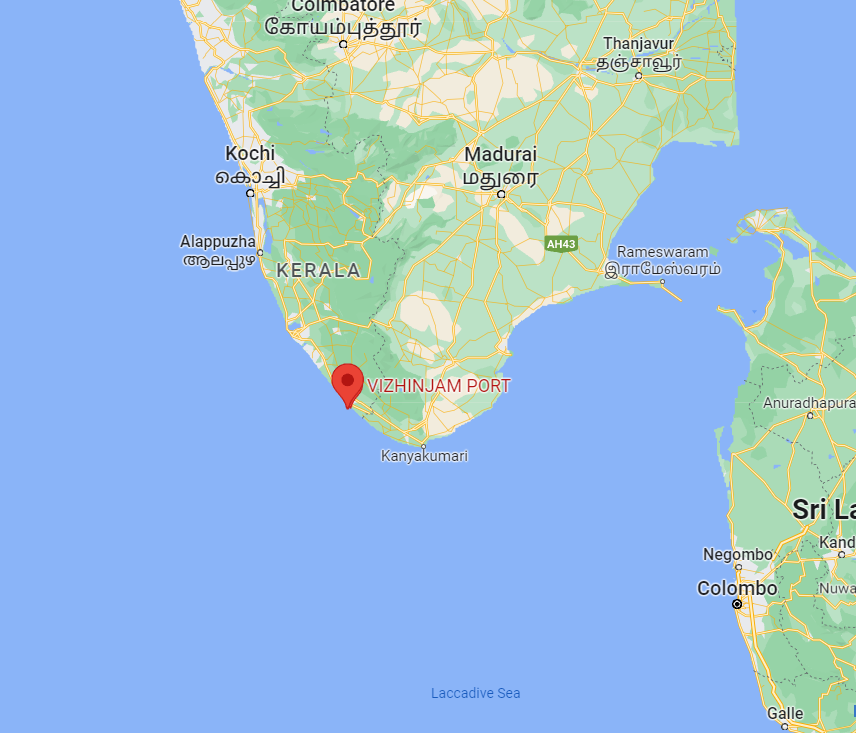Indian Economy
Vizhinjam International Seaport Project
- 20 Oct 2023
- 4 min read
For Prelims: Vizhinjam International Seaport, Public Private Partnership
For Mains: Issues and Challenges in Development Projects in India, Growth, Development and Employment, Ports.
Why in News?
The Vizhinjam International Seaport Project, India's first deepwater transshipment port, has gained attention recently as the first cargo ship arrived at the port.
Note
- A transshipment deepwater seaport is a port that can handle large ships that carry cargo from one place to another.
- It has a deep water channel and a large berth area for loading and unloading goods. It also allows the transfer of cargo from one ship to another at the port.
What is the Vizhinjam International Seaport Project?
- The Vizhinjam International Transhipment Deepwater Multipurpose Seaport is an ambitious project taken up by the Government of Kerala.
- It is designed to primarily cater to the transshipment and gateway container business with provision for a cruise terminal, liquid bulk berth and facilities for additional terminals.
- The port is currently being developed with a Public Private Partnership , with Adani Ports Private Limited with a component structured on a design, build, finance, operate, and transfer ("DBFOT") basis.
- It is strategically situated near Thiruvananthapuram, Kerala. Its location along the southern coast of India provides easy access to international shipping routes.
- It is positioned to compete with global transshipment hubs like Colombo, Singapore, and Dubai, reducing the cost of container movement to and from foreign destinations.
- The port boasts a natural depth of more than 18 meters, which can be further scaled up to 20 meters.
- This depth is crucial as it enables the port to accommodate large vessels and mother ships with substantial cargo capacities.
- Initial capacity in the first phase is set at one million (twenty-foot equivalent units)TEUs, with potential for expansion to 6.2 million TEUs.
- Project Progress:
- Expected to generate 5,000 direct job opportunities and stimulate an industrial corridor and cruise tourism.
- The project is approximately 65.46% complete. The project has experienced delays over the years, mainly due to factors like natural disasters, protests, and logistical challenges.
- The current timeline anticipates the first phase's operational readiness by December 2024.
Why India Needs a Deepwater Container Transshipment Port?
- India has 12 major ports. However, the country lacks a landside mega-port and terminal infrastructure to deal with ultra-large container ships.
- Hence, nearly 75% of India’s transshipment cargo is handled at ports outside India, mainly Colombo, Singapore, and Klang.
- In fiscal 2021-22, the total transshipment cargo of India was about 4.6 million TEUs, out of which about 4.2 million TEUs were handled outside India.
- Developing a port into a Transshipment Hub will accrue significant benefits such as forex savings, foreign direct investment, increased economic activity at other Indian Ports, development of related logistics infrastructure, employment generation, improved operation/logistics efficiencies and increase in revenue share.
- It also encourages related businesses, including ship services, logistics, and bunkering.
- A deepwater container transshipment port can attract a large share of the container transshipment traffic which is now being diverted to Colombo, Singapore and Dubai.
UPSC Civil Services Examination, Previous Year Question (PYQ)
Prelims
Q. Recently, which of the following States has explored the possibility of constructing an artificial inland port to be connected to the sea by a long navigational channel? (2016)
(a) Andhra Pradesh
(b) Chhattisgarh
(c) Karnataka
(d) Rajasthan
Ans: (d)









